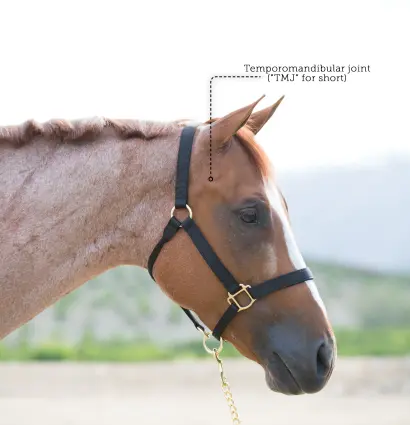Temporomandibular Joint (TMJ) Conditions in Horses
Updated January 4, 2024

What is TMJ?
The temporomandibular joint (“TMJ”) is where the lower jaw or mandible connects with the upper jaw or maxilla through the temporal bone of the skull. On the horse, the TMJ can be found about midway on a straight line drawn between the outside corner of the eye to the base of the ear on the same side. It is fairly easy to see when the horse is chewing.
Although the TMJ is technically a joint – like the shoulder joint, elbow joint, and fetlock joint – the ends of the bones (the articular cartilage) are covered with fibrocartilage instead of hyaline cartilage. This can make it react a little differently at times than other joints.
TMJ Issues in Horses
There are a number of issues that can cause pain or dysfunction in and around the temporomandibular joint. It is a complex area consisting of many different and connected parts. The area includes a wide variety of tissue types such as bone, articular cartilage, tendons, ligaments, muscle, nerves, blood vessels, salivary glands, and more.
It also has the challenging tasks of chewing plus communicating with the rider through the bit. Causes of TMJ pain include:
- trauma to the area, such as a kick or accident that results in a subluxation (partial dislocation), fracture, or other damage
- arthritis, chronic “wear and tear”
- inflammation
- infection
- muscle and soft tissue problems, and possibly more
Signs and Symptoms of TMJ
Although a horse with a temporomandibular joint condition may have heat, pain, and swelling in the area, many of the signs and symptoms of a TMJ disorder are general and could be caused by other problems. These include dental disease, gastric ulcers, neck arthritis, headshaking disease, behavioral and training problems, a variety of musculoskeletal issues such as lameness, and others. Signs of discomfort and issues in the temporomandibular joint may appear as:
- Head tossing
- Resisting bridling, not accepting the bit, or becoming head shy
- Tilting the head or changes in the way the horse carries its head
- Sticking the tongue out
- Mild performance issues such as difficulty turning, stopping, picking up a certain lead, or collecting
- More severe performance issues such as sticking the head straight up, refusing to move forward, backing up, rearing, bucking, or spooking
- Decreased appetite or difficulty chewing and eating, including quidding, which is dropping food out of the mouth while chewing
How to Test for and Diagnose TMJ in Horses
A horse showing any of these signs should be examined by a veterinarian to identify the root cause of the problem, provide the horse immediate comfort, and correct the underlying issue. Expect the vet to perform a complete physical examination since this list of problems is not specific just to temporomandibular joint conditions.
However, if there is heat, pain, or swelling in the TMJ area upon palpation, jaw muscle atrophy, a bony enlargement or protuberance, or restricted range of motion of the TMJ itself, then the vet may concentrate on this area with further diagnostic tests.
For example, just like in joints of the limbs, a numbing agent or local anesthetic can be injected into the TMJ region to see if blocking pain makes a difference. Joint fluid can be collected for testing if an infection is suspected. Imaging tools such as radiographs (X-rays), ultrasound, or even Computed Tomography (CT can be helpful in confirming the diagnosis or establishing a prognosis.
Treatment for TMJ in Horses
Treatment of temporomandibular joint problems will depend upon the underlying cause and the exact tissues affected. For example, if dental disease is determined to be the trigger factor, then corrective work in the mouth should be performed to ensure proper bite and alignment. If the source of the problem is an infection, then long-term antibiotics may be prescribed.
In the case of arthritis or simple “wear and tear,” one or more corticosteroids, HA, or combination joint injections may be given.
Depending on the trigger factor, diet changes and NSAIDs may be recommended in the short-term. Complementary and alternative therapy such as chiropractic, massage, acupuncture, and others may also be advised to help restore the horse’s body back to normal.